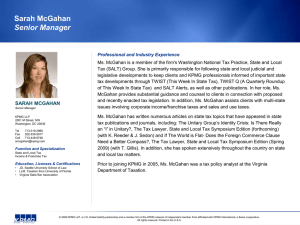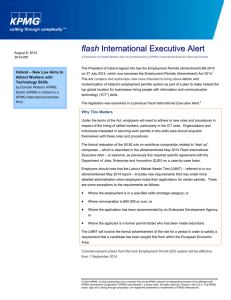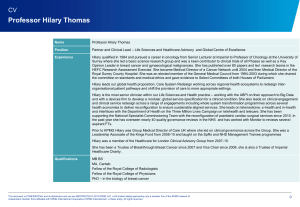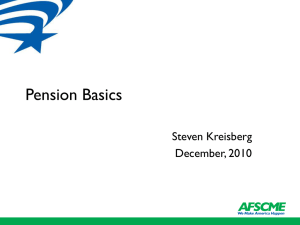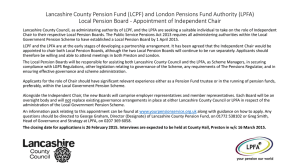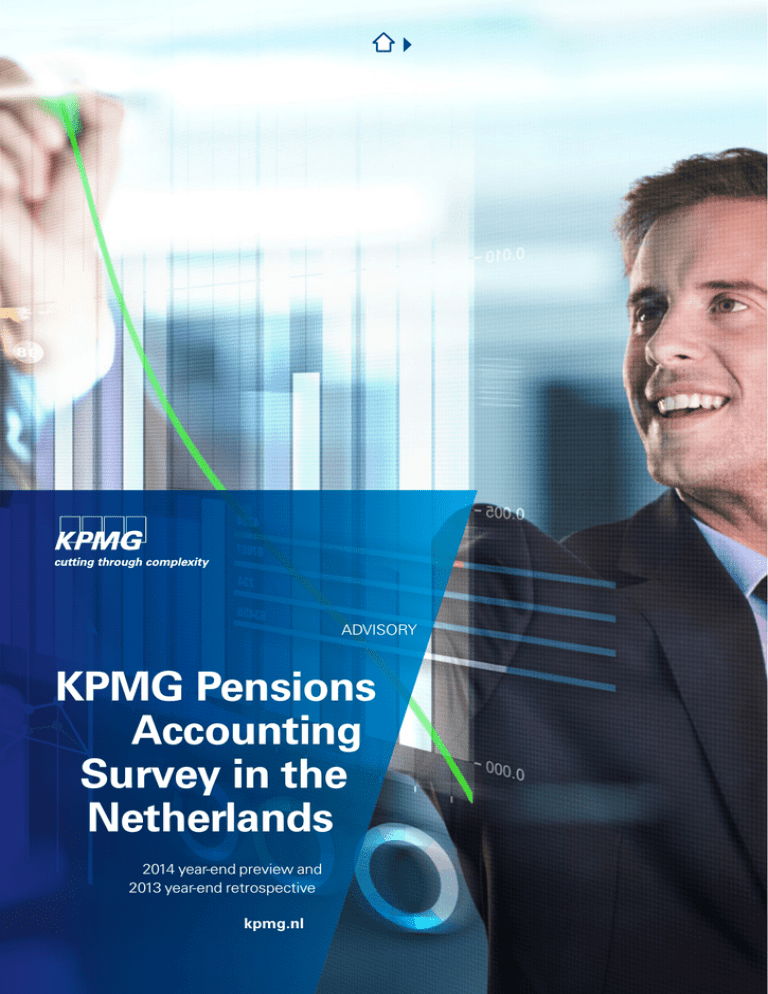
ADVISORY
KPMG Pensions
Accounting
Survey in the
Netherlands
2014 year-end preview and
2013 year-end retrospective
kpmg.nl
2 | KPMG Pensions Accounting Survey in the Netherlands
Introduction3
Headlines4
Impact of pension legislation
4
Other trends and changes
5
Discount rate
6
Inflation rate
10
Life expectancy
11
About KPMG the Netherlands
13
© 2014 KPMG Advisory N.V.
2014 year-end preview and 2013 year-end retrospective | 3
Introduction
Under IFRS, companies have to estimate the value of their pension liability. IAS 19
(Revised) prescribes the assumptions used to calculate the liability and the asset
values covering that liability. Paragraphs 75-98 provide guidelines to determine these
assumptions, but actuarial advisors interpret and apply the guidelines in different
ways, resulting in a wide variety of assumptions being used. Therefore, company
directors are facing a broad range of alternatives in terms of actuarial assumptions.
As from 1 January 2013, reporting
requirements under IAS 19 have
changed. The main changes under
IAS 19 (Revised) (hereafter: IAS 19R)
are the abolition of the corridor method,
the replacement of expected return on
assets and interest cost by a single ‘net
interest cost’ item based on the discount
rate, and guidance on accounting for
employee contributions. IAS 19R offers
a clearer distinction between defined
benefit and defined contribution plans
and the requirements to disclose
additional information.
In this year’s KPMG Pensions Accounting
Survey, we take a closer look at the
developments in IAS 19R and how this
standard is being applied, and at the
assumptions companies used to value
their pension liabilities as at 2013
year-end.
© 2014 KPMG Advisory N.V.
The figures shown in this material are
based on publicly available information
on companies quoted on the Euronext
Amsterdam stock exchange. The survey
covers companies advised by all the
major actuarial firms and therefore
provides some insight into market
practice in the Netherlands.
4 | KPMG Pensions Accounting Survey in the Netherlands
Headlines
• Over the course of 2014, discount
rates have dropped sharply. Should
this trend continue or should interest
rates stabilise at the current levels,
IAS 19R liabilities will be significantly
higher at 2014 year-end than at the
end of 2013.
• The IFRS Interpretations Committee
(IFRIC) has clarified the treatment of
employee contributions in defined
benefit plans.
• IAS 19R discount rates used at the
end of 2013 on average increased
slightly compared to the previous
year, however, this sometimes
varied per advisor and discount rate
methodology.
31 December 2013 while others have
accounted for, or will account for,
them over the course of 2014. It is
apparent that companies have been
applying different methodologies to
account for these changes.
• A continuing trend is visible of
companies reporting under IFRS
changing the risk profile of their
defined benefit pension plans in such
a way that they qualify as defined
contribution plans under IAS 19R.
• Due to a number of recent changes
in pensions legislation in the
Netherlands, the majority of (Dutch)
pension plans have had to be
amended. Many companies already
accounted for these changes as at
Impact of pension legislation
• Effective as of 1 January 2014,
pensions legislation in the
Netherlands has changed, and further
changes are expected to come into
effect on 1 January 2015. In essence,
the changes reduce the tax
advantages of accruing for pensions:
- As from 1 January 2014, the
(tax-advantageous) retirement age
increased from 65 to 67 and the
maximum pension accrual (in a
career-average plan) was reduced
from 2.25% per annum to 2.15%
per annum;
© 2014 KPMG Advisory N.V.
- As from 1 January 2015, the
(tax-advantageous) pension accrual
is expected to be further reduced
to 1.875% per annum and the
pensionable salary to be capped
at EUR 100,000 per annum.
• At the same time, the supervisory
framework for pension funds will
become more stringent, resulting in
higher cash contributions being
required, although this may be offset
by the reduction in pension accruals.
As a result, the pensions sector has
expressed concerns that pension
contributions will not decrease on
a macro-level, but that there will be
less room for pension increases due
to the new supervisory framework.
• For companies reporting under IFRS,
the impact of the proposed changes
regarding the tax-advantageous
treatment of pensions will, for most
companies, result in (one-off) P&L
gains if the pension plan is changed
to comply with the new legislation.
The changes in the supervisory
framework do not have a direct
impact on IAS 19R figures.
2014 year-end preview and 2013 year-end retrospective | 5
Other trends and changes
• A significant number of Dutch
companies that need to amend
their pension plans as a result of
the changes in legislation are
seizing the opportunity to abolish
the IAS 19R defined benefit
accounting requirement all together,
for example by changing their defined
benefit plans to collective defined
contribution (CDC) plans. Financial
institutions in particular are adopting
this practice, largely driven by
the adverse impact of IAS 19R
pension liabilities on solvency
capital requirements for banks and
insurers.
© 2014 KPMG Advisory N.V.
• IAS 19R provides guidelines on
accounting for employee
contributions and employer
contribution ceilings. Furthermore,
the application of these guidelines is
subject to strict conditions. No clear
consensus has been reached on the
interpretation of these guidelines by
advisors and auditors. In November
2013, the IASB clarified the
accounting requirements for
employee contributions. In practice
this means that, for most pension
plans, the employee contributions
may be deducted from the service
cost, in line with the practice adopted
by most companies prior to the
introduction of IAS 19R.
6 | KPMG Pensions Accounting Survey in the Netherlands
Discount rate
The defined benefit obligation of any
scheme is calculated by discounting
estimated future cash flows. According
to IAS 19R (paragraph 83), the discount
rate used should be determined by
reference to market yields on highquality corporate bonds at the balance
sheet date. It is market practice to use
corporate bonds with an AA rating (or
equivalent) for this purpose.
Differences in advised discount
rates
As the requirements of IAS 19R
discount rates are rather principlebased, different actuarial firms advise
their clients to use different discount
rates in the Eurozone. The graph below
shows the discount curves at year-end
2013 constructed by several actuarial
firms advising the Dutch market. The
differences result from different
methodologies used by the firms.
For example, some actuarial firms
use a different definition of their bond
universe. Furthermore, due to the
absence of AA-rated corporate bond
liquidity for long maturities, further
differences arise that are inherent to the
extrapolating methodologies necessary
to calculate the yields beyond the last
liquid section of the curve.
Zero coupon yield curves at 31 December 2013
5.0%
Spot rate
4.0%
3.0%
2.0%
1.0%
0.0%
1
2
3
4
5
6
7
8
9
10 11 12 13 14 15 16 17 18 19 20 21 22 23 24 25 26 27 28 29 30
Maturity (years)
TOPIC / Market / Date
© 2014 KPMG Advisory N.V.
2014 year-end preview and 2013 year-end retrospective | 7
For a 15-year maturity, the advised
discount rate varies based on the
different methodologies applied from
3.2% to 3.7%. For a 25-year maturity,
discount rates vary from 3.6% to 4.0%.
Compared to 2012, the average advised
discount rate for a 15- year maturity has
increased by 30bps to 3.4%.
As the calculated value of a defined
benefit obligation is highly dependent on
the discount rate, differences in advised
discount rates can have a significant
impact on the value that needs to be
reported. The graph below illustrates
this impact, comparing the estimated
increase in defined benefit obligation to
Impact on DBO of minimum versus maximum discount rates
18%
16%
Increase in DBO
14%
12%
10%
8%
6%
4%
2%
0%
5
10
15
Maturity (years)
TOPIC / Market / Date
© 2014
2013 KPMG Advisory N.V.
20
25
30
be reported when using the lowest
advised discount rate and when using
the highest advised discount rate. For a
15-year maturity, the defined benefit
obligation calculated using the lowest
discount rate curve is approximately
7.4% greater than for the highest curve.
8 | KPMG Pensions Accounting Survey in the Netherlands
DISCOUNT RATE
Historical and expected development
in corporate AA bonds
In 2013, the financial markets, and
particularly the bond market, were
less turbulent than they were in 2012.
Spreads were more stable and there
was less movement in the AA-rated
bond universe. However, over the first
nine months of 2014, interest rates
dropped significantly, with spreads
remaining more or less stable, as
the graph below clearly shows.
Benefit obligations may for many plans
increase by 20 to 30% as a result of the
decrease in the discount rate. It is not
expected that such an increase will be
matched by a similar increase in plan
assets. Company balance sheets will
therefore be hit by this trend.
Development of 15-year spot rate
3.50%
Percentage
3.00%
2.50%
2.00%
1.50%
KPMG AA
© 2014 KPMG Advisory N.V.
ECB AAA
Sep 2014
Aug 2014
Jul 2014
Jun 2014
May 2014
Apr 2014
Mar 2014
Feb 2014
Jan 2014
Dec 2013
1.00%
2013 year-end preview and 2013 year-end retrospective | 9
Discount rates used by listed
companies
The figure below shows the discount
rates applied by the companies
surveyed at the end of 2013.
An average discount rate of 3.65% was
used, with over 70% of the companies
researched using a discount rate of
between 3.4% and 4.0%. The average
discount rate was 16.5bps higher
than the average discount rate used
at year-end 2012. However, the trend
shown in the graph above suggests
that a sharp decline in discount rates
will be visible at the end of 2014.
25.00%
18.87%
20.00%
20.75%
18.87%
15.00%
9.43%
3.77%
3.77%
0.00%
≥ 5.0%
4.4%
4.2%
4.0%
3.8%
3.6%
3.4%
3.2%
1.89%
Discount rates
© 2014 KPMG Advisory N.V.
5.66%
1.89%
3.0%
0.00%
2.6%
0.00%
0.00%
3.77%
4.8%
5.66%
2.8%
5.66%
2.4%
5.00%
4.6%
10.00%
< 2.4%
Percentage of companies
Discount rates at 31 December 2013
10 | KPMG Pensions Accounting Survey in the Netherlands
Inflation rate
The graph below shows the term
structures for inflation (Euro swap
implied inflation curves) for year-end
2012 and 2013, as well as at the end of
September 2014. The graph shows a
declining trend in inflation rates, with
the swap implied inflation dropping
below 2% over the course of 2014.
This decrease was larger than market
movements would suggest, but still
relatively consistent with the graph
shown below, and with the ECB’s
long-term inflation rate expectation
of 2%.
Compared to the end of 2012,
short-term inflation in particular has
decreased, and overall inflation has
decreased further over the course
of 2014.
Inflation rates used at year-end 2013
On average, at year-end 2013 Dutch
companies assumed an inflation rate of
1.5%, against 2.2% at the end of 2012.
Euro swap implied inflation
2.50%
Inflation rate
2.00%
1.50%
1.00%
0.50%
0.0%
1
2
3
4
5
6
7
8
9
10 11 12 13 14 15 16 17 18 19 20 21 22 23 24 25 26 27 28 29 30
Maturity (years)
31-12-2012
© 2014 KPMG Advisory N.V.
31-12-2013
30-09-2014
2014 year-end preview and 2013 year-end retrospective | 11
Life expectancy
Most of the companies in scope use the
mortality tables issued by the Dutch
Actuarial Association (Actuarieel
Genootschap, hereafter ‘AG’). The
mortality table most used at the end of
2013 was the AG 2012-2062 table, which
was issued in 2012. Mortality tables
incorporating a future trend for life
expectancy have been prevalent for a
number of years now, with companies
invariably using such mortality tables,
sometimes adjusted for experience
ratings for a specific industry sector or
membership profile. In September
2014, the AG issued a new mortality
table (AG 2014) which we expect will be
used by a number of companies for the
2014 year-end IAS 19 figures. The tables
below show the life expectancies
predicted by both the AG 2012-2062
and the AG 2014 mortality tables.
Life expectancy based on AG2012-2062
Male
Female
age
2014
2039
2064
2014
2039
2064
0
86.4
86.7
86.9
87.1
87.3
87.4
25
61.4
61.9
62.0
62.3
62.4
62.5
45
40.5
42.0
42.2
42.1
42.7
42.7
65
20.4
22.7
23.2
22.9
24.1
24.4
85
5.8
6.6
7.0
7.0
7.8
8.2
Life expectancy based on AG2014
Male
Female
age
2014
2039
2064
2014
2039
2064
0
89.9
92.4
94.1
92.2
94.5
96.1
25
62.4
65.3
67.5
65.1
67.7
69.6
45
40.2
43.6
46.2
43.2
46.1
48.4
65
19.7
22.9
25.5
22.8
25.6
27.8
85
5.8
6.9
7.9
6.8
8.0
9.2
© 2014 KPMG Advisory N.V.
Overall, life expectancy is still showing
an increasing trend, although life
expectancy for, in particular, males
who are currently 65 years old, has
decreased slightly. This is due to a
slightly higher mortality rate in the
past few years than forecast by the
AG 2012-2062 table.
12 | KPMG Pensions Accounting Survey in the Netherlands
LIFE EXPECTANCY
The graph below shows life expectancy
for 65-year olds, as forecast by the new
AG 2014 table, compared to the AG
2012-2062 table.
As can be seen from the graph, for
pension plans with a membership
predominantly consisting of young
females, pension costs will increase
as a result of an improvement in
longevity. For more mature plans
wwith a predominantly male population,
the impact will be limited.
Life expectancy of 65-year olds
29
Life expectancy (years)
27
25
23
21
19
Year
AG2014 (males)
AG2014 (females)
AG2012-2062 (males)
AG2012-2062 (females)
TOPIC / Market / Date
© 2014 KPMG Advisory N.V.
2062
2056
2050
2044
2038
2032
2026
2014
2020
17
2014 year-end preview and 2013 year-end retrospective | 13
About KPMG the Netherlands
KPMG Netherlands offers services in
the fields of audit, tax and advisory.
We offer our services to a broad group of
clients: major domestic and international
companies, medium-sized enterprises,
non-profit organisations and government
institutions. The complicated problems
faced by our clients require a multidisciplinary approach. Our professionals
stand out in their own specialist fields
while, at the same time, working
together to offer added value that
enables our clients to excel in their
own environment. In doing so, we draw
from a rich source of knowledge and
experience, gained worldwide in the
widest range of different organisations
and markets. We provide real answers
so that our clients can make better
decisions.
© 2014 KPMG Advisory N.V.
Financial Risk management (FRM)
Financial Risk Management offers
creative business strategies to clients
in the rapidly changing insurance and
pensions industry. We also bring insight
and quantitative analytic skills to other
clients assisting them with the
challenges they are facing. We support
numerous pension funds and companies
with advice on pension plan design,
pension valuations and risk analysis.
Our team of (qualified) actuaries works
together with other KPMG professionals
to form multi-disciplinary teams and
guarantee the best service for our
clients.
Contact us
Alexander van Stee
T: +31 (0)20 656 4673
E: vanstee.alexander@kpmg.nl
Peter Bosschaart
T: +31 (0)20 656 4404
E: bosschaart.peter@kpmg.nl
www.kpmg.nl
The information contained herein is of a general nature and is not intended to address the circumstances of any particular individual
or entity. Although we endeavor to provide accurate and timely information, there can be no guarantee that such information is
accurate as of the date it is received or that it will continue to be accurate in the future. No one should act on such information
without appropriate professional advice after a thorough examination of the particular situation.
© 2014 KPMG Advisory N.V., registered with the trade register in the Netherlands under number 33263682, is a member firm of the
KPMG network of independent member firms affiliated with KPMG International Cooperative (‘KPMG International’), a Swiss entity.
All rights reserved. The name KPMG, logo and ‘cutting through complexity’ are registered trademarks of KPMG International.


